Della Robbia Sculpture in Florence

Basilica of Santa Maria del Fiore, consecrated 1436, Florence; dome designed by Filippo Brunelleschi. Photograph: Jan Wlodarczyk, Alamy
The cathedral of Santa Maria del Fiore is the quintessential monument of Renaissance Florence, its towering masonry dome faced with terracotta tiles rhyming with the warm brick and stone of the city and complementing the green and blue tones of the surrounding hills.
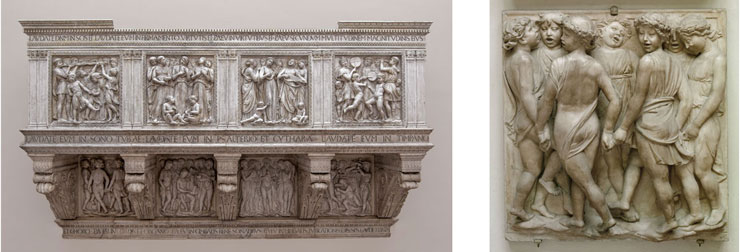
(Left) Luca della Robbia, Cantoria (organ loft), 1431–1438, marble, Museo dell'Opera del Duomo, Florence. Photograph courtesy Opera di S. Maria del Fiore
(Right) Luca della Robbia, Panel from the Cantoria, 1431–1438, marble, Museo dell'Opera del Duomo, Florence. Photograph: Erich Lessing/Art Resource, NY
Luca della Robbia completed several works of sculpture inside the cathedral, including one of the cantorie, or organ lofts, commissioned in the 1430s, when the dome was just being completed under the supervision of architect Filippo Brunelleschi. The cantoria design features children singing, dancing, and playing instruments in praise of the Lord. This work demonstrates Luca’s skill as a sculptor in marble, another medium in which the Della Robbia excelled.
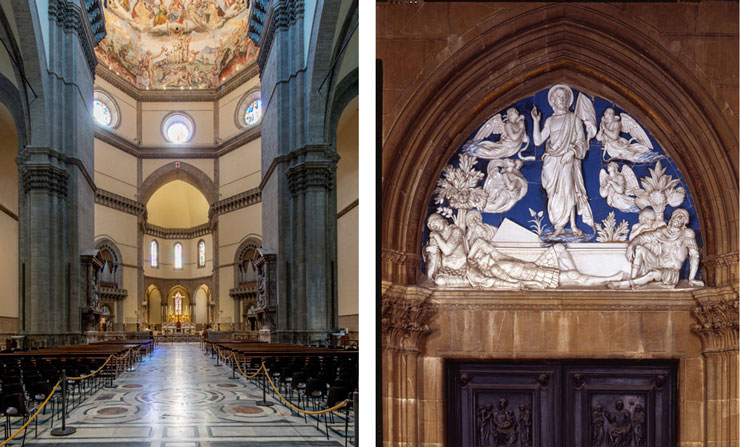
(Left) Interior of Santa Maria del Fiore, Florence. Photograph: Antonio Quattrone
(Right) Resurrection lunette in situ above a door to the sacristy. Photograph courtesy Opera di S. Maria del Fiore
Luca also sculpted a pair of large-scale glazed terracotta reliefs for the lunettes above the sacristy doors in the cathedral, positions of special prominence to the left and right of the high altar.
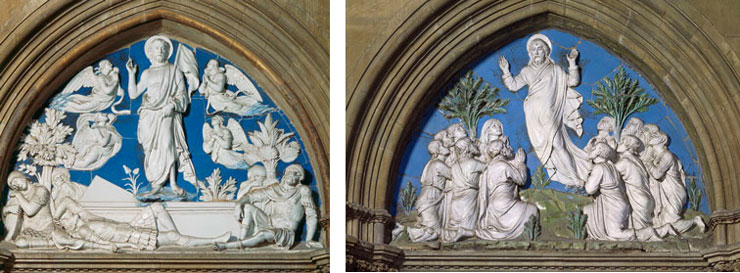
(Left) Luca della Robbia, Resurrection, 1442–1445, Santa Maria del Fiore, Florence. Photograph: Scala/Art Resource, NY
(Right) Luca della Robbia, Ascension, 1446–1451, Santa Maria del Fiore, Florence. Photograph: Scala /Art Resource, NY
The first relief represents Christ’s resurrection on the third day after his death on the cross. Luca’s figures stand out strongly against the blue background by virtue of their modeling and white color, rendering them clear and readable even at a distance. The companion relief depicts the ascension of Christ to heaven 40 days after his resurrection. This composition is distinguished by a greater variety of color, especially in the greens that characterize the earthly realm from which Jesus ascends.
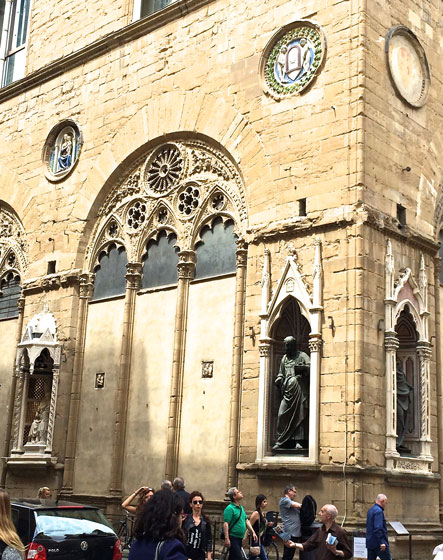
View of the south side of Orsanmichele, 14th–15th century, Florence
Originally a grain market, the large building known as Orsanmichele later became a church supported by Florence’s professional trade guilds. Luca della Robbia created glazed terracotta roundels depicting the coats of arms of three such guilds; the sculptures are placed high above the tripartite arcades. Renaissance Florentines would have encountered them while walking on the main street leading from the civic center of Piazza della Signoria to the cathedral.
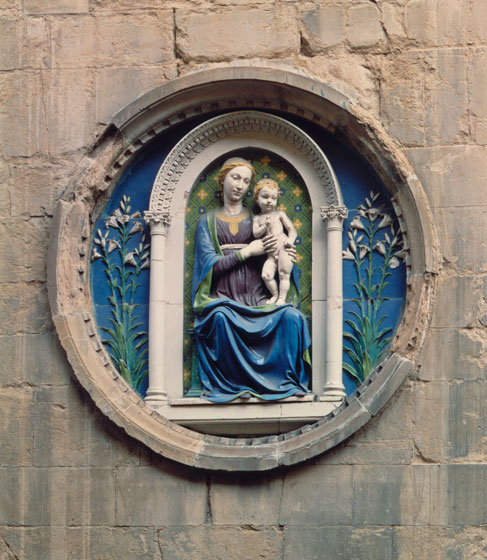
Luca della Robbia, Coat of Arms of the Guild of Doctors and Apothecaries, c. 1460, Orsanmichele, Florence. Photograph: Scala/Art Resource, NY
Luca’s roundel honoring the association of doctors, pharmacists, and spice merchants presents the guild’s protectors, the Madonna and Child, against a patterned background of green, yellow, and blue that may represent a luxurious fabric. Lilies, symbolic of both the Virgin and Florence, grow alongside the arched shrine that surrounds the figures.
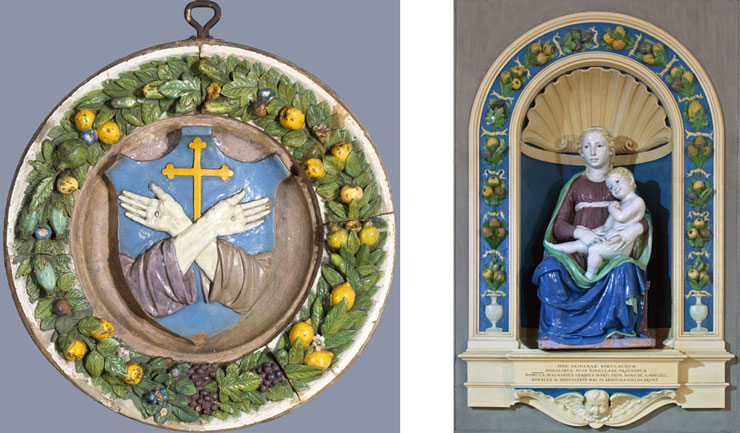
(Left) Attributed to Luca della Robbia the Younger, Coat of Arms of the Franciscan Order, c. 1525, North Carolina Museum of Art, Raleigh. Purchased with funds from the North Carolina State Art Society (Robert F. Phifer Bequest), G.55.25.2
(Right) Luca della Robbia, Madonna and Child, c. 1450–1460, Oratory of San Tommaso Aquino, Florence. Photograph: Emanuele Vergari Fotografo, Firenze. Conservation of this work was made possible through the support of Friends of Florence
The bright, durable colors of Della Robbia glazes were particularly suitable for making coats of arms—of guilds, religious institutions and orders, and families—which were often set into the exterior walls of buildings or courtyards. A coat of arms of the Franciscan order, attributed to Luca’s great-nephew Luca della Robbia the Younger, appears in the exhibition. So does a Madonna and Child statuette by Luca himself, glazed with a range of colors similar to his Madonna in the coat of arms for the guild of doctors and pharmacists at Orsanmichele.
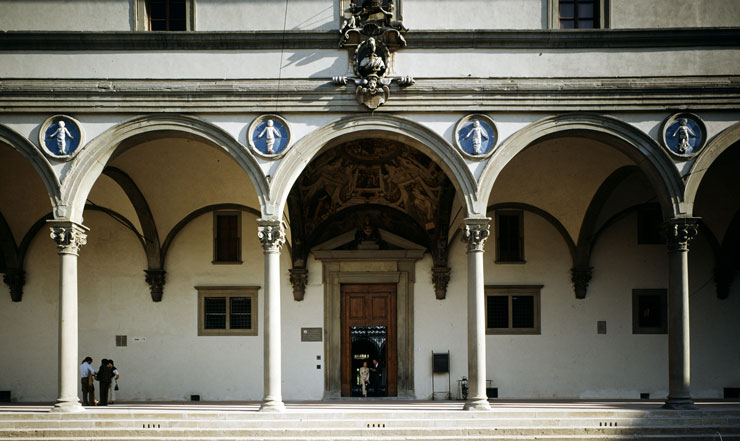
Filippo Brunelleschi and Andrea della Robbia, Ospedale degli Innocenti, designed 1419–1424, sculptures installed 1487, Florence. Photograph: Bridgeman Images
The Ospedale degli Innocenti (Hospital of the Innocents), dedicated to the care of orphaned and abandoned children, was designed by Filippo Brunelleschi in the 15th century with an elegant loggia, or covered arcade, overlooking Piazza Santissima Annunziata. Andrea della Robbia decorated the spandrels of the loggia with circular reliefs of swaddled infants on a blue ground.
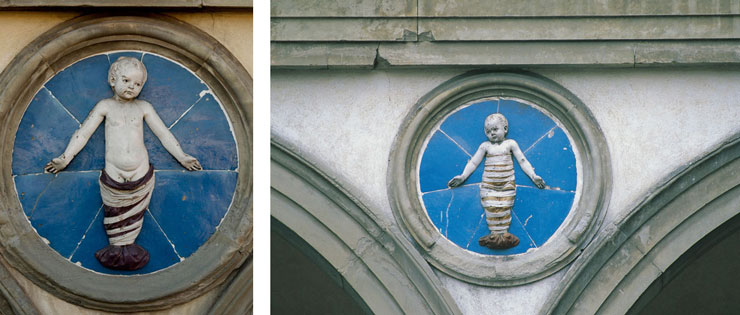
(Left) Andrea della Robbia, Roundel, installed 1487, Ospedale degli Innocenti, Florence, Photograph: Antonio Quattrone
(Right) Andrea della Robbia, Roundel, installed 1487, Ospedale degli Innocenti, Florence, Photograph: Universal Images Group North America LLC, DeAgostini, Alamy
The Innocenti roundels count among the most recognizable productions of the Florentine Renaissance. The figures are represented as individuals deserving of charity. Each baby appears different in pose, swaddled in various colors, each face unique in character and expression. Collectively, the reliefs manifest a new Renaissance interest in childhood as a distinct stage of life. The Della Robbia showed a particular affinity for the representation of children, their sculptures both reflecting and serving to shape perceptions of youth in 15th-century Florence.
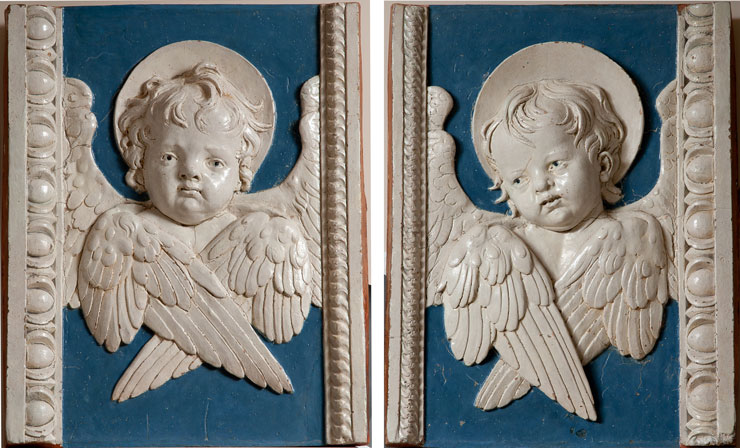
Andrea della Robbia, Cherubs, c. 1500, private collection. Photographs: Bruce Schwarz
Affecting images of children from the family’s workshop feature prominently in the exhibition. Like the Innocenti foundlings, this pair of reliefs by Andrea was once part of a series integrated into an architectural setting. Sensitive modeling and variations in pose evoke each subject’s unique character.
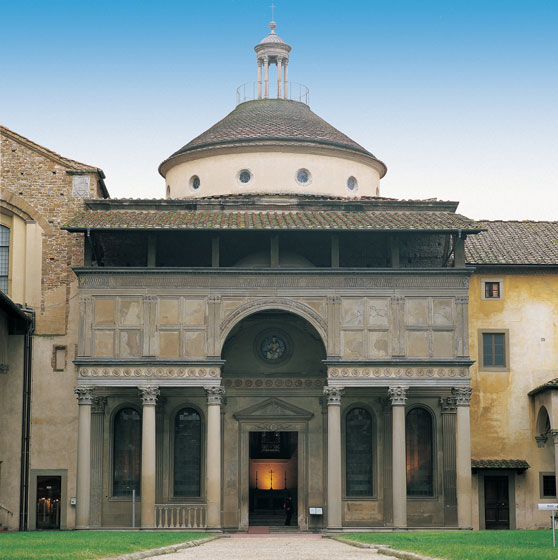
Filippo Brunelleschi, exterior of the Pazzi chapel, designed 1420s, built 1442–c. 1465, Church of Santa Croce, Florence. Photograph: Mondadori Portfolio/Electa/Arnaldo Vescovo/Bridgeman Images
Between about 1440 and 1461, the Della Robbia adorned another of Brunelleschi's works: the chapter house in the cloister of the Franciscan church of Santa Croce. Named the Pazzi chapel for its patron, the building, with its elegant portico and cupola, became an influential example of modern architecture founded on classical principles.
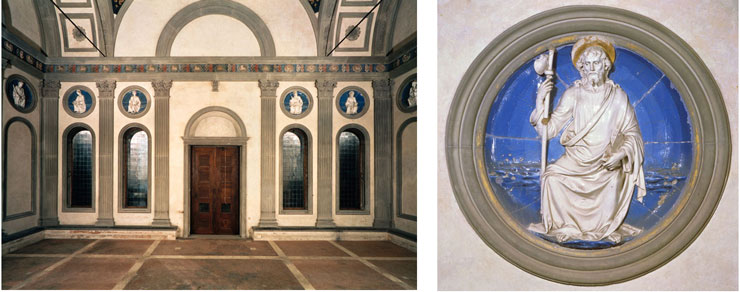
(Left) Interior of the Pazzi chapel. Photograph: Scala/Art Resource, NY
(Right) Detail of a roundel of an apostle. Photograph: Scala/Art Resource, NY
Luca sculpted circular medallions of the 12 Apostles, the early disciples of Jesus and preachers of the Gospel, including Andrew, James, and John, for the walls of the chapel interior. The roundels are glazed primarily in the signature Della Robbia colors of white against blue.
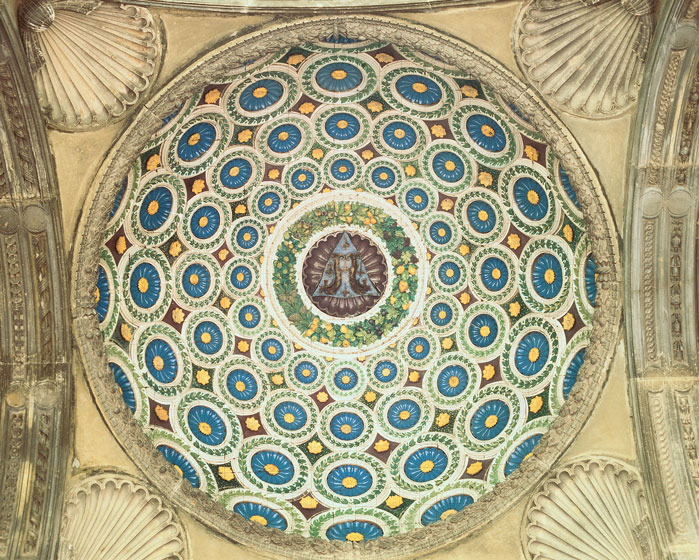
Luca della Robbia and Filippo Brunelleschi, Dome of the portico, Pazzi Chapel, 1461, Church of Santa Croce, Florence. Photograph: Scala/Art Resource, NY
Luca also complemented the architect’s design for the cupola of the portico by covering its inner surface with a coffered pattern of molded tiles. At center appears the Pazzi coat of arms encircled by a fruit and flower garland. Around this, circles of blue and yellow rosettes, ringed with green, leafy wreaths, gradually expand in scale. This brilliantly colorful, reflective, and long-lasting decoration created an effect of opulence contained by rigorous geometry. Both the cupola and its decoration were completed well after Brunelleschi’s death in 1446.
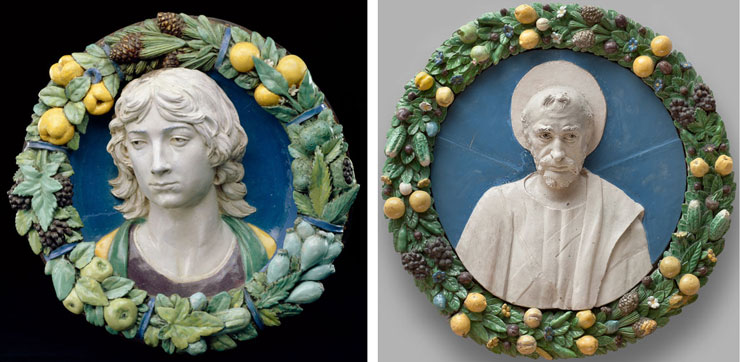
(Left) Andrea della Robbia, Roundel with Head of a Youth, c. 1470–1480, Detroit Institute of Arts, Gift of Henry Ford Hospital personnel in memory of Edsel B. Ford, 43.477. Photograph: Bridgeman Images
(Right) Andrea della Robbia, Roundel with Bust of a Saint, c. 1485–1490, The Nelson-Atkins Museum of Art, Kansas City, Missouri, Purchase: William Rockhill Nelson Trust. Photograph: Tiffany Matson
These portrait reliefs in the exhibition are set within roundels encircled by garlands of fruit and leaves, similar to the wreath at the center of the Pazzi cupola ceiling. The individualized expressions of the figures, a young man and an elderly saint, show similarities to the apostles of the chapel walls.
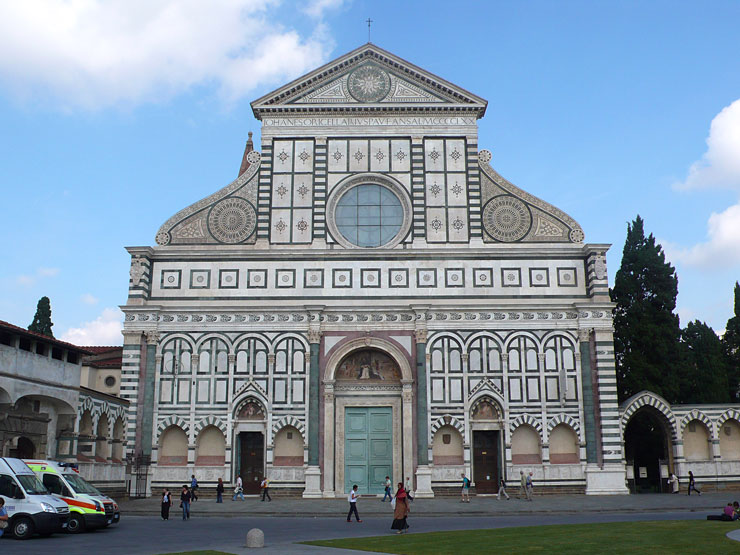
Leone Battista Alberti, façade of Santa Maria Novella, c. 1458–1470, Florence. Photograph: Bridgeman Images
In the last decade of the 15th century, Giovanni della Robbia worked in the sacristy of the great Dominican church of Santa Maria Novella. The magnificent façade of patterned green and white stone was designed by the architect Leon Battista Alberti.
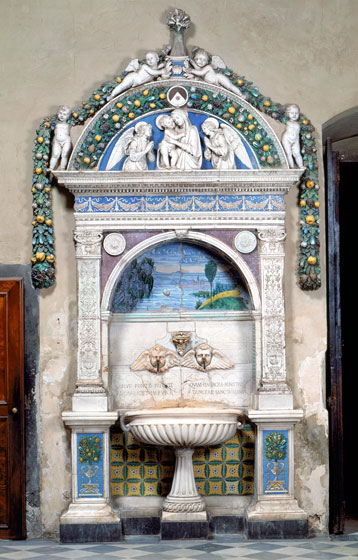
Giovanni della Robbia, Lavabo (washbasin), 1498, Church of Santa Maria Novella, Florence. Photograph: Serge Domingie, © Alinari/Art Resource, NY
Here Giovanni created a lavabo, or washbasin, whose elaborate design comprises carved marble, painted flat tiles, pilasters decorated with figural sculpture, and an early example of pure landscape imagery in the glazed terracotta lunette. Children standing on the cornice support heavy swags of fruit and leaves on their shoulders. Before this cornucopia of sculptural elements suggesting themes of purification and natural abundance, the priest would wash his hands and cleanse his spirit before moving to the altar.

Andrea della Robbia, Tabernacle, 1470s, Isabella Stewart Gardner Museum, Boston
Other Della Robbia sculptures incorporating the forms of Renaissance architecture to serve the needs of churches include this tabernacle featured in the exhibition. In the glazed relief, angels venerate the bread for the sacrament of communion, once contained in a rectangular receptacle under a vault hung with curtains at the center.